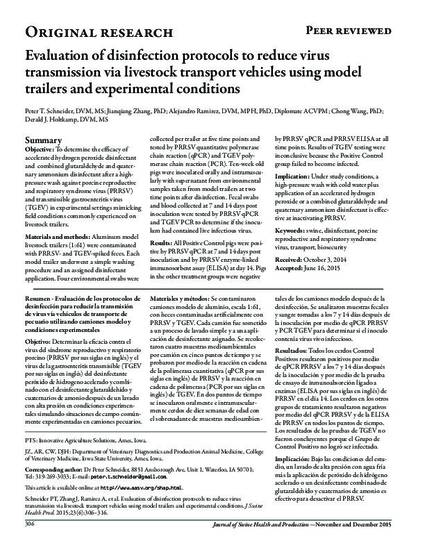
Objective: To determine the efficacy of accelerated hydrogen peroxide disinfectant and combined glutaraldehyde and quaternary ammonium disinfectant after a high-pressure wash against porcine reproductive and respiratory syndrome virus (PRRSV) and transmissible gastroenteritis virus (TGEV) in experimental settings mimicking field conditions commonly experienced on livestock trailers.
Materials and methods: Aluminum model livestock trailers (1:61) were contaminated with PRRSV- and TGEV-spiked feces. Each model trailer underwent a simple washing procedure and an assigned disinfectant application. Four environmental swabs were collected per trailer at five time points and tested by PRRSV quantitative polymerase chain reaction (qPCR) and TGEV polymerase chain reaction (PCR). Ten-week old pigs were inoculated orally and intramuscularly with supernatant from environmental samples taken from model trailers at two time points after disinfection. Fecal swabs and blood collected at 7 and 14 days post inoculation were tested by PRRSV qPCR and TGEV PCR to determine if the inoculum had contained live infectious virus.
Results: All Positive Control pigs were positive by PRRSV qPCR at 7 and 14 days post inoculation and by PRRSV enzyme-linked immunosorbent assay (ELISA) at day 14. Pigs in the other treatment groups were negative by PRRSV qPCR and PRRSV ELISA at all time points. Results of TGEV testing were inconclusive because the Positive Control group failed to become infected.
Implication: Under study conditions, a high-pressure wash with cold water plus application of an accelerated hydrogen peroxide or a combined glutaraldehyde and quaternary ammonium disinfectant is effective at inactivating PRRSV.
Available at: http://works.bepress.com/chong-wang/80/

This article is from Journal of Swine Health and Production 23 (2015): 306. Posted with permission.